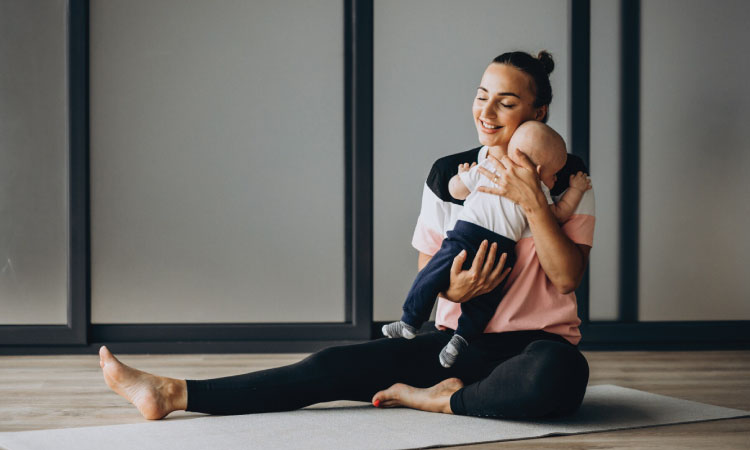Navigating the post-C-section recovery journey involves both patience and understanding of your body’s needs. “When can I sit on the floor after a C-section?” is a query that frequently crosses the minds of new mothers.
While the focus is often on the health of the newborn, it’s equally vital for mothers to consider various factors before resuming normal activities after a c-section, including floor sitting, doing housework after a c-section, or even deciding how and when to use the Indian toilet after a c-section.
Some women have concerns about sneezing, coughing, and even laughing after a C-section.The extent to which cesarean sections limit a new mother’s ability to move around after giving birth varies from one woman to another.
You can safely get back to sitting on the ground post-c-section if you know what to expect from the recovery process, take into account your unique circumstances, and go at your own pace. This blog post offers caution and advice for floor sitting after a C-section.
How Long After C-Section Can I Bend Down?
Doctors usually advise against doing certain things, like bending over, for a while to speed up healing and lower the chance of problems after a C-section. For instance, medical professionals advise against lifting anything heavier than your baby during the first six weeks after a C-section1.
Likewise, it is recommended that it is not a safe time to sit on the floor after a cesarean for the first 4-6 weeks after a c-section.
During a cesarean section, the OB-GYN carefully makes incisions through multiple layers of tissue. The procedure involves making an incision in the abdominal skin and its underlying connective tissue (fascia), as well as the four layers of abdominal muscles.
Related Reading: 11 Foods To Avoid After Cesarean Delivery – Know Them Here
The peritoneum, a protective membrane that surrounds the uterus, is also accessible, along with the muscular wall of the uterus.
When bending down to get into a sitting position after a c-section, you can put a significant amount of strain on the sutures that were used to seal your incisions. It’s important to keep in mind that these sutures were not intended to withstand heavy pressure and hold your tissues together.
- Leaning forward, even slightly, raises the pressure within the abdomen. The heightened internal pressure puts strain on the abdominal muscles that are in the process of healing following a C-section.
- Pregnancy can lead to a weakening of the abdominal and other core muscles. Cesarean delivery has a greater impact on the abdominal muscles compared to vaginal delivery2.
Thus, it is important to allow the body at least 6 weeks for the incision to heal and for the abdomen to recover from the trauma. It’s a good idea to wait until new mothers can do movements like bending down without experiencing any pain.
Doing a gradual return to the floor sitting after the C-section rather than hurrying up is the best course of action.
Typically, doctors will schedule a check-up around 6 weeks after your C-section to assess the healing progress of your scar. If they tell you that you are “healing normally,” then you can consider bending down and deciding the timing for sitting on the floor after a C-section.
As your body continues to heal and the pain subsides with movement, you can gradually experiment with bending between weeks 4 and 6. Start by bending slightly, just a few inches, and then gently stand back up. Carry on at a leisurely pace and stop bending if the discomfort becomes too much to bear. Just wait a day or two and give it another go. There’s no need to rush.
How Long Can I Sit After C-Section?

The answer to the question, “When can I resume sitting on the floor post-c-section?” is when your body is ready. The timeline varies from person to person.
It takes more time to recover after a C-section than after a vaginal delivery. Following a cesarean section (C-section) delivery, it is generally recommended for women to refrain from certain positions, such as sitting on the floor, for a specific duration. However, the floor sitting restrictions after a C-section end after 6 weeks.
It is important to understand the proper way to sit after a C-section. You can not simply collapse onto the floor like you did previously. Once you feel confident in your ability to bend and straighten up independently, you can try sitting on the floor. Carefully lower yourself while holding on to something.
After a cesarean section (C-section), a woman’s ability to sit on the floor without discomfort varies from person to person and depends on things like how well she is healing and how she is feeling overall.
Every new mom’s recovery timeline is distinct, and certain women may find themselves at ease sitting on the floor earlier than others.
When it comes to the duration of sitting on the floor after a C-section, it is important to pay attention to your body’s signals and refrain from engaging in activities that may cause discomfort or pain. Also, it is very important to adopt the proper sitting position after the C-section.
What Is The Best Position To Sit After C-Section?
Before worrying about “When can I resume sitting on the floor post c-section?” it is important to understand how you should sit after the c-section.
It is important to prioritize comfort and support while choosing a sitting position after a c-section to promote healing and minimize discomfort. Following are some helpful suggestions for finding a comfortable sitting position after a c-section. It is important to consider that personal preferences and comfort levels can differ, so it is crucial to pay attention to your body and make necessary adjustments.
1. Sit upright
Keeping an upright position while sitting can help reduce any extra pressure on the surgical site. Avoid slouching. It’s crucial to take deep breaths and let your lungs expand after surgery, particularly abdominal surgery such as a C-section.
Sitting upright supports optimal lung function. Maintaining a proper sitting position after a c-section can also reduce the likelihood of experiencing back pain, a common occurrence following surgery.
2. Use supportive pillows
Sitting on the floor safely post-cesarean requires some external support. For added comfort when sitting, try placing a cushion behind your back. In addition to assisting with proper posture, this may lessen pressure on the area of your incision.
If you feel pressure in your pelvic region from your buttocks while sitting down, think about placing a small pillow or cushion below them.
3. Take breaks and shift positions
Remember to take regular breaks to stand up, stretch, and move around if you’ve been sitting for a while. Gentle movement helps prevent stiffness and promotes circulation. Change your sitting position regularly to prevent muscle stiffness and discomfort.
Listen to your body and adjust as needed. When getting up from a seated position, use your arms to support your abdomen and minimize strain on the incision area. If available, use armrests to assist with sitting down and getting up.
Related Reading: How To Keep C-section Incision Dry When Overweight?
4. Sit on a firm surface
Choose a firm surface to sit on. Avoid an overly soft or sagging surface, as it may not provide adequate support. Sitting on a firm surface can help distribute your body weight more evenly, reducing pressure on the incision site.
On the other hand, soft surfaces may allow your body to sink, potentially causing more strain on the abdominal muscles and the surgical incision.
Moreover, getting up from a firm surface may be easier for individuals who have undergone a C-section, as it provides a more stable base for movement.
What Postures Should You Avoid After C-Section?

Following a C-section, it is crucial to be aware of your body and refrain from positions that may strain the incision area or compromise your healing process. Although everyone’s experiences may differ, here are some sitting positions to avoid after a section
1. Sitting with crossed legs
An avoidable sitting position is to sit cross-legged after the c-section. Crossing your legs while sitting can strain the pelvic area3. It may cause stress on the abdominal muscles and the area where the incision was made.
Participating in activities that put a strain on the abdominal muscles shortly after a C-section may potentially hinder the healing process.
2. Avoid postures that necessitate slouching or hunching over
Avoiding postures that necessitate slouching or hunching over is particularly important after a cesarean section (C-section) to promote healing, reduce discomfort, and prevent potential complications.
Related Reading: 12 Permanent Body Changes After Pregnancy That Women Experience
Slouching or hunching over can put additional stress on the incision site, potentially causing discomfort and hindering the healing process. There could be long-term effects if the uterus does not heal properly following a cesarean section4.
3. Avoid positions that involve twisting or rotating the torso
Twisting or rotating the torso can place unnecessary stress on the abdominal muscles and the C-section incision site. This stress may increase the risk of complications such as wound dehiscence (the separation of the wound edges) or delayed healing 5.
Twisting or rotating movements can contribute to the development of scar tissue around the incision area.
4. Deep reclining position
A C-section involves an incision in the abdominal wall and uterus. Deep reclining positions can put additional stress on the incision site, potentially causing discomfort and slowing down the healing process.
Also, sitting in deep, low chairs or sofas requires you to use your abdominal muscles to get up. This can put a strain on your incision area. Sometimes getting up from deep reclining positions can increase the risk of complications such as wound dehiscence.
Related Reading: 9 Signs Of A C-Section Infection To Watch Out For
5. Unsupported straight-legged sitting
A C-section involves an incision through the abdominal wall to access the uterus, and the abdominal muscles are directly impacted during the procedure. Your abdominal muscles, including any that the surgery may have impacted, may experience additional strain if you sit with your legs straight out in front of you without any support.
Also, sitting in this position may cause your lower back to round, putting stress on the lumbar spine.
Remember to listen to your body and take it easy during the initial weeks following a C-section. If you have concerns about your sitting positions or experience pain, share them with your doctor without hesitating. Prolonged periods of sitting (even while maintaining good posture) can increase the risk of blood clots and hinder your recovery. Take breaks and walk around regularly.


